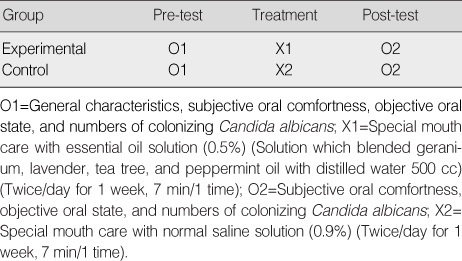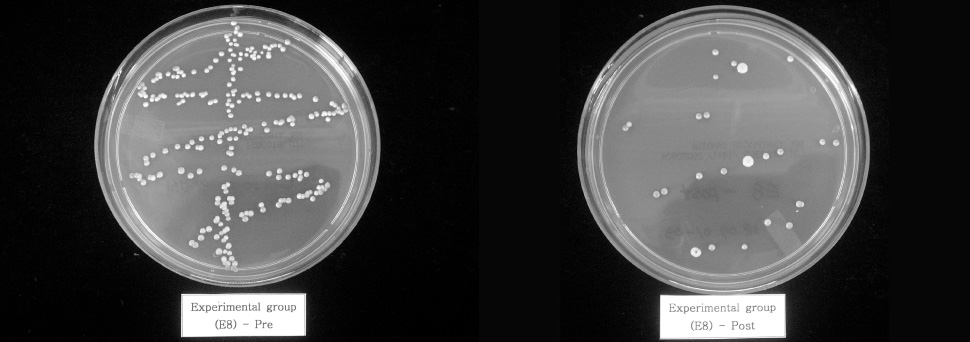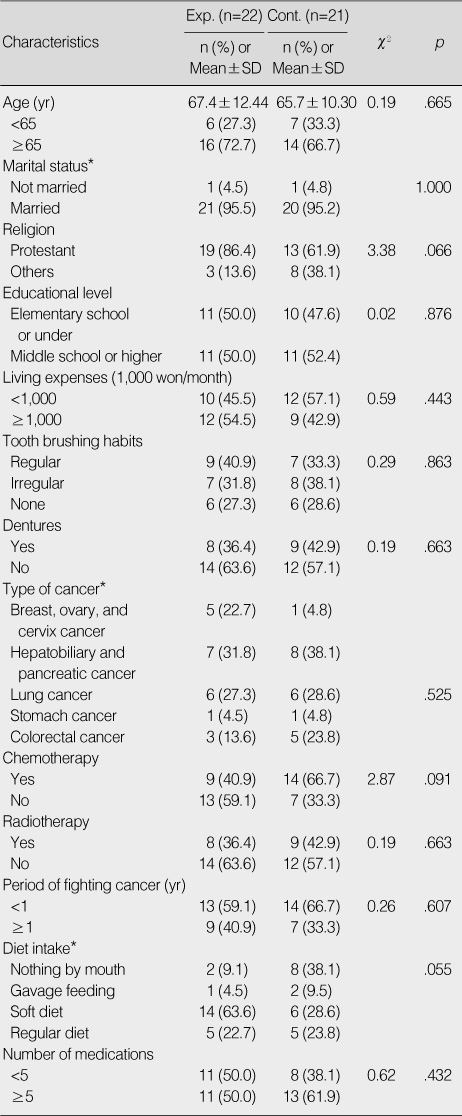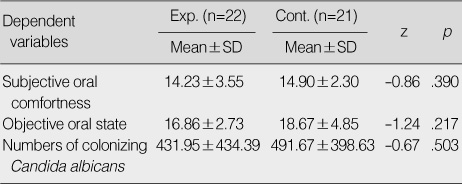Articles
- Page Path
- HOME > J Korean Acad Nurs > Volume 40(4); 2010 > Article
-
Original Article
- Effects of Oral Care with Essential Oil on Improvement in Oral Health Status of Hospice Patients
- Hee-Young Kang, Song-Sook Na, Yun-Kyung Kim
-
Journal of Korean Academy of Nursing 2010;40(4):473-481.
DOI: https://doi.org/10.4040/jkan.2010.40.4.473
Published online: August 31, 2010
1Assistant Professor, Department of Nursing, Chosun University, Ulsan, Korea.
2Full-time Lecturer, Christian College of Nursing, Ulsan, Korea.
3Full-time Lecturer, Department of Nursing, Choonhae College of Health Sciences, Ulsan, Korea.
- Address reprint requests to: Kim, Yun-Kyung. Department of Nursing, Choonhae College of Health Sciences, San 72-10 Gokcheon-ri, Ungchon-myeon, Ulju-gun, Ulsan 689-784, Korea. Tel: 82-52-270-0195, Fax: 82-52-270-0189, dove4678@hanmail.net
Copyright © 2010 Korean Society of Nursing Science
Abstract
-
Purpose
- This study was done to examine the effects of oral care with essential oil in improving the oral health status of hospice patients with terminal cancer.
-
Methods
- The participants were 43 patients with terminal cancer admitted to K hospital in G city, Korea. Twenty-two patients were assigned to the experimental group and 21 to the control group. Participants in the experimental group received special mouth care with essential oil (application of essential oil mixture consisting of geranium, lavender, tea tree, and peppermint). The control group received special mouth care with 0.9% saline. The special mouth care was performed twice daily for one week in both groups. The scores for subjective oral comfortness, objective oral state, and numbers of colonizing Candida albicans were measured before and after the treatment.
-
Results
- The score for subjective oral comfortness and objective oral state were significantly higher in the experimental group compared to the control group. The numbers of colonizing Candida albicans significantly decreased in the experimental group compared to the control group.
-
Conclusion
- Oral care with essential oil could be an effective oral health nursing intervention for hospice patients with terminal cancer.
- 1. Baik SH. The effects of xylitol and sorbitol on oral health and xerostomia in Korean elderly. Journal of Korean Gerontological Nursing. 2005;7:88–103.
- 2. Beck S. Impact of a systematic oral care protocol on stomatitis after chemotherapy. Cancer Nursing. 1979;2:185–199.PubMed
- 3. Buckle J. Ha HJ Kim HS Kang HS . Clinical aromatherapy in nursing of Buckle, Jane. 2003;Seoul, Hyunmoonsa.
- 4. Cho WH. Comparison of water jet irrigation and gauze cleansing method on oral hygiene for patients in the intensive care unit. 2004;Seoul, Seoul National University. Unpublished master's thesis.
- 5. Choi JS, Jun MH, Kim YH. Prevention of chemotherapy induced oral mucositis in patients with acute leukemia by the two oral care protocols-the comparisons of sodium bicarbonate-normal saline gargling and chlorhexidine gargling. Journal of Korean Academy of Adult Nursing. 1997;9:98–111.
- 6. Chun SM. Effects of cold oral gargling on the oral discomfort among patients receiving chemotherapy. 2003;Busan, Pusan National University. Unpublished master's thesis.
- 7. Chung SH. The effects of essential oil mouthrinse on oral health in the community indwelling elderly. Journal of Korean Academy of Nursing. 2006;36:84–93.PubMed
- 8. Cohen J. Statistical power analysis for the behavioral sciences. 1988;2nd ed. Hillsdale, NJ, Lawrence Erlbaum Associates.
- 9. Dudjak LA. Mouth care and for mucositis due to radiation therapy. Cancer Nursing. 1987;10:131–140.PubMed
- 10. Eilers J, Epstein JB. Assessment and measurement of oral mucositis. Seminars in Oncology Nursing. 2004;20:22–29.ArticlePubMed
- 11. Epstein JB, Polsky B. Oropharyngeal candidiasis: A review of its clinical spectrum and current therapies. Clinical Therapeutics. 1998;20:40–57.ArticlePubMed
- 12. Fine DH, Furgang D, Barnett ML, Drew C, Steinberg L, Charles CH, et al. Effect of an essential oil-containing antiseptic mouthrinse on plaque and salivary Streptococcus mutans levels. Journal of Clinical Periodontology. 2000;27:157–161.ArticlePubMed
- 13. Huh SY, Jung MA, Kim HS, Kwon IG, Hong JH, Park EY. The effect of GM-CSF oral gargle vs traditional betadine or chlorhexidine oral gargle in chemotherapy-induced stomatitis. Journal of Korean Clinical Nursing Research. 2003;8:169–182.
- 14. Hur MH, Park J, Maddock-Jennings W, Kim DO, Lee MS. Reduction of mouth malodour and volatile sulphur compounds in intensive care patients using an essential oil mouthwash. Phytotherapy Research. 2007;21:641–643.ArticlePubMed
- 15. Jeon LS, Kang SK, Chun YH, Hong JP. A clinical study about effectiveness of essential oil-containing dental paste in controlling oral malodor. Journal of Korean Academy of Oral Medicine. 2005;30:141–148.
- 16. Kim BJ, Gong SH, Kim YH, Seol ME, Lee SG, Lee EM, et al. Care of cancer patients: Symptom management. 2001;Seoul, Hyunmunsa.
- 17. Kim NC, Kim HJ. The effect of teatree oil gargling on oral cavity micro-organism growth and perceived discomfort of patient receiving chemotherapy. Journal of Korean Academy of Adult Nursing. 2005;17:276–286.
- 18. Koh SJ, Lee KS, Hong YS, Yoo YS, Park HJ. Clinical change of terminally III cancer patients at the end-of-life time. Korean Journal of Hospice and Palliative Care. 2008;11:99–105.
- 19. Mortality and cause of death in Korea. Korean Statistical Information Service (KOSIS). 2008;Retrieved January 8, 2010. from http://kosis.kr/metadata/.
- 20. Lee HR, Kang HS. The effect of oral care by using yogurt on the reduction of tongue coating and the oral comfort in patients with tube feeding. Journal of Korean Clinical Nursing Research. 2006;11:163–176.
- 21. Lee IS, Lee GJ. Effects of lavender aromatherapy on insomnia and depression in women college students. Journal of Korean Academy of Nursing. 2006;36:136–143.ArticlePubMedPDF
- 22. Lee KN, Tae YS. The effects of mouth care oral discomfort of cancer patient undergoing chemotherapy. Journal of Korean Academy of Adult Nursing. 1999;11:785–795.
- 23. Lee MK, Kim HR, Ro BI. Identification of candida species by analysis of rRNA spacer regions. Korean Journal of Medical Mycology. 2006;11:13–18.
- 24. Lee SH, Kim SW, Bang YJ. A study on the distribution of oral Candidial isolates in diabetes. Korean Journal of Medical Mycology. 2002;7:139–148.
- 25. Lim NY, Kang HS, Oh SY, Kim WO, Lee SH, Kim JI, et al. Fundamentals of nursing skills. 2008;Seoul, Soomoonsa.
- 26. Park YJ. Influence of saline and betadine solution for gargle in the leukemic patients receiving chemotherapy. 1997;Gwangju, Chonnam National University. Unpublished master's thesis.
- 27. Pizzo G, La Cara M, Licata ME, Pizzo I, D'Angelo M. The effects of an essential oil and an amine fluoride/stannous fluoride mouthrinse on supragingival plaque regrowth. Journal of Periodontology. 2008;79:1177–1183.ArticlePubMed
- 28. Sharma S, Saimbi CS, Koirala B, Shukla R. Effectof various mouthwashes on the levels of interleukin-2 and interferon-gamma in chronic gingivitis. The Journal of Clinical Pediatric Dentistry. 2008;32:111–114.PubMed
REFERENCES
Figure & Data
REFERENCES
Citations

- Protective effects of Pelargonium graveolens (geranium) oil against cefotaxime-induced hepato-renal toxicity in rats
Shaimaa M. Azzam, Heba M. A. Elsanhory, Ahmed H. Abd El-Slam, Marwa S. M. Diab, Halima Mohamed Ibrahim, Abdalrahman Mohammed Yousef, Fatma Mahmoud Sabry, Ebtihal Y. Khojah, Somaiah A. Bokhari, Gad Elsayed Mohamed Salem, Marwa Saad Zaghloul
Frontiers in Toxicology.2024;[Epub] CrossRef - The enhanced sulfidation mechanism of surface activation in hemimorphite through ammonium complexation: An experimental and density functional theory study
Jing Cao, Dandan Wu, Qi Zuo, Shuming Wen
Applied Surface Science.2024; 655: 159685. CrossRef - Effect of molecular weight and content of polyvinylpyrrolidone on cell proliferation, loading capacity and properties of electrospun green tea essential oil-incorporated polyamide-6/polyvinylpyrrolidone nanofibers
Sara Khataei, Mastafa H.Al-Musawi, Kaveh Asadi, Soghra Ramezani, Mojtaba Abbasian, Marjan Ghorbani
Journal of Drug Delivery Science and Technology.2023; 82: 104310. CrossRef - The impact of aromatherapy-based oral care on oral conditions, salivary pH, and halitosis in older adults with dementia: Pilot study
Ae Kyung Chang, Bo kyoung Kim, Ah Young Kim
Geriatric Nursing.2023; 53: 109. CrossRef - Melatonin Enhanced Drought Stress Tolerance and Productivity of Pelargonium graveolens L. (Herit) by Regulating Physiological and Biochemical Responses
Ragia M. Mazrou, Fahmy A. S. Hassan, Mohamed Magdy F. Mansour, Mohamed M. Moussa
Horticulturae.2023; 9(11): 1222. CrossRef - Comparison of chemical composition and activities of essential oils from fresh leaves of Pelargonium graveolens L′Herit. extracted by hydrodistillation and enzymatic pretreatment combined with a solvent-free microwave extraction method
Liang Wei, Huiying Yang, Hui Li, Minghua Zhu, Shengcheng Mi, Qi Lu, Mengran Liu, Yuangang Zu
Industrial Crops and Products.2022; 186: 115204. CrossRef - Surface modification of hemimorphite by using ammonium carbamate and its response to flotation
Jing Cao, Jing Yang, Dandan Wu, Ziang Wang, Huiqin Chen
Applied Surface Science.2022; 605: 154775. CrossRef - Extraction and Formulation of Perfume from Pelargonium Graveolens Essential Oil
Gosavi Akshata A, Kanase Jyoti A, Kanse Apeksha S, Adhalrao Supriya B, Khaladkar Shraddha M
International Journal of Advanced Research in Science, Communication and Technology.2022; : 823. CrossRef - Evaluation of Essential Oils and Extracts of Rose Geranium and Rose Petals as Natural Preservatives in Terms of Toxicity, Antimicrobial, and Antiviral Activity
Chrysa Androutsopoulou, Spyridoula D. Christopoulou, Panagiotis Hahalis, Chrysoula Kotsalou, Fotini N. Lamari, Apostolos Vantarakis
Pathogens.2021; 10(4): 494. CrossRef - Effects of Oral Gargling with Aroma Solution in Psychiatric Inpatients: A Non-Randomized Controlled Trial
Yun Ah Jung, Hee Sook Kim
Journal of Korean Academy of Nursing.2020; 50(2): 200. CrossRef - Aloe vera-Peppermint Gel (Veramin)
Stephanie Maxine Ross
Holistic Nursing Practice.2020; 34(2): 129. CrossRef - Effects of Gargling with an Aroma Solution on Xerostomia, Halitosis, and Salivary pH in Hemodialysis Patients – A Randomized Controlled Trial
Min Young Oh, Mi-Kyoung Cho
The Open Nursing Journal.2019; 13(1): 1. CrossRef - The Impact of Systematic Oral Care on Oral Health Status in Patients of Intensive Care Units
Vajihe Atashi, Ahmadreza Yazdannik, Hosein Mahjobipoor, Hojjatollah Yousefi, Reza Bekhradi
Journal of Health and Care.2018; 20(3): 244. CrossRef - Improving the growth, yield and volatile oil content of Pelargonium graveolens L. Herit by foliar application with moringa leaf extract through motivating physiological and biochemical parameters
E.F. Ali, F.A.S. Hassan, M. Elgimabi
South African Journal of Botany.2018; 119: 383. CrossRef - Volatile oil from alpinia officinarum promotes lung cancer regression in vitro and in vivo
Ning Li, Qingyu Zhang, Zhenbin Jia, Xiaohong Yang, Haitao Zhang, Hui Luo
Food & Function.2018; 9(9): 4998. CrossRef - Chemical composition, biological activities and DNA damage protective effect of Pelargonium graveolens L’Hér. essential oils at different phenological stages
Maher Boukhris, Fatma Hadrich, Haifa Chtourou, Abdelhafith Dhouib, Mohamed Bouaziz, Sami Sayadi
Industrial Crops and Products.2015; 74: 600. CrossRef - Effects of Special Mouth Care with an Aroma Solution on Oral Status and Oral Cavity Microorganism Growth in Elderly Stroke Patients
Eun-Hye Lee, Hyojung Park
Journal of Korean Academy of Nursing.2015; 45(1): 46. CrossRef - Tapping botanicals for essential oils: Progress and hurdles in cancer mitigation
Seema Patel, Pratibha Gogna
Industrial Crops and Products.2015; 76: 1148. CrossRef - Effects of Meatal Care with Essential Oil on the Meatal Status of Elderly Women Patients
Jin Kim, Se-Young Kim, In Sun No
Journal of Korean Academy of Fundamentals of Nursing.2015; 22(2): 139. CrossRef - Antioxidant properties of Pelargonium graveolens L’Her essential oil on the reproductive damage induced by deltamethrin in mice as compared to alpha-tocopherol
Ahlem Ben Slima, Manel Ben Ali, Mohamed Barkallah, Al Ibrahim Traore, Tahia Boudawara, Noureddine Allouche, Radhouane Gdoura
Lipids in Health and Disease.2013;[Epub] CrossRef - The Essential Oil of Melaleuca alternifolia (Tea Tree Oil) and Its Main Component, Terpinen-4-ol Protect Mice from Experimental Oral Candidiasis
Kentaro Ninomiya, Naho Maruyama, Shigeharu Inoue, Hiroko Ishibashi, Toshio Takizawa, Haruyuki Oshima, Shigeru Abe
Biological and Pharmaceutical Bulletin.2012; 35(6): 861. CrossRef - Effects of A-solution on Halitosis and Oral Status in Preoperative NPO Patients
Ji-Ah Song, Myung-Haeng Hur
Journal of Korean Academy of Nursing.2012; 42(3): 405. CrossRef


Figure 1
Figure 2
Homogeneity Test for General and Disease related Characteristics of Participants (N=43)
*Fisher's exact test.
Exp.=experimental group; Cont.=control group.
Homogeneity Test for Outcome Variables at Baseline (N=43)
Exp.=experimental group; Cont.=control group.
Changes of Outcome Variables between the Experimental and Control Group (N=43)
Exp.=experimental group (n=22); Cont.=control group (n=21).
*Fisher's exact test. Exp.=experimental group; Cont.=control group.
Exp.=experimental group; Cont.=control group.
Exp.=experimental group (n=22); Cont.=control group (n=21).
 KSNS
KSNS
 E-SUBMISSION
E-SUBMISSION





 Cite
Cite

